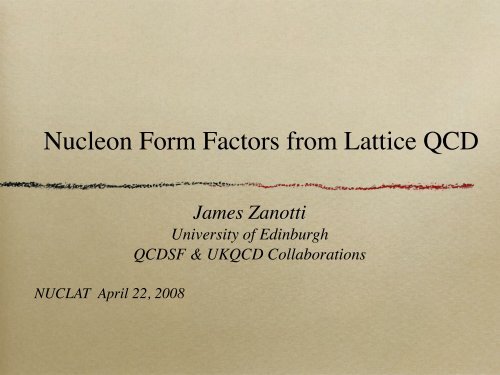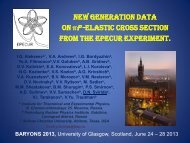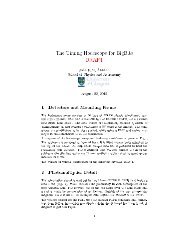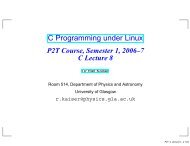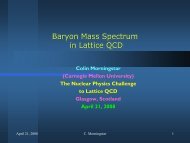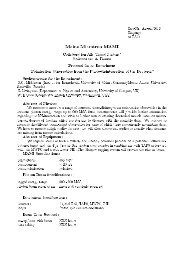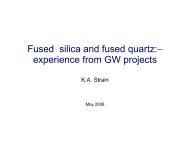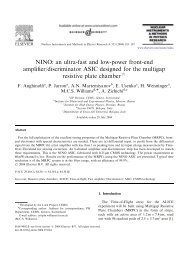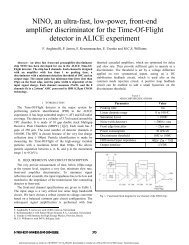Nucleon Form Factors from Lattice QCD
Nucleon Form Factors from Lattice QCD
Nucleon Form Factors from Lattice QCD
Create successful ePaper yourself
Turn your PDF publications into a flip-book with our unique Google optimized e-Paper software.
<strong>Nucleon</strong> <strong>Form</strong> <strong>Factors</strong> <strong>from</strong> <strong>Lattice</strong> <strong>QCD</strong><br />
NUCLAT April 22, 2008<br />
James Zanotti<br />
University of Edinburgh<br />
<strong>QCD</strong>SF & UK<strong>QCD</strong> Collaborations
Acknowledgements<br />
<strong>QCD</strong>SF:<br />
M. Goeckeler<br />
Ph. Haegler<br />
R. Horsley<br />
Y. Nakamura<br />
D. Pleiter<br />
RBC/UK<strong>QCD</strong>:<br />
Y.Aoki<br />
T. Blum<br />
H.W. Lin<br />
M. Lin<br />
P. Rakow<br />
A. Schaefer<br />
G. Schierholz<br />
W. Schroers<br />
H. Stueben<br />
S. Ohta<br />
S. Sasaki<br />
R. Tweedie<br />
T. Yamazaki
Outline<br />
Electromagnetic <strong>Form</strong> <strong>Factors</strong><br />
Introduction & Motivation<br />
Experimental Status<br />
<strong>Lattice</strong> Techniques<br />
q 2 Scaling<br />
Static Quantities (Magnetic Moment, Charge Radii)<br />
Accessing Small q 2<br />
Twisted Boundary Conditions<br />
Conclusions and Outlook
Introduction to <strong>Form</strong> <strong>Factors</strong><br />
F(q 2 )<br />
q 2<br />
If a nucleon was a point-like object with no internal structure,<br />
a probe would simply measure its e.g. charge for all q 2
Introduction to <strong>Form</strong> <strong>Factors</strong><br />
F(q 2 )<br />
q1<br />
q 2<br />
If a nucleon was a point-like object with no internal structure,<br />
a probe would simply measure its e.g. charge for all q 2
Introduction to <strong>Form</strong> <strong>Factors</strong><br />
F(q 2 )<br />
q2<br />
q 2<br />
If a nucleon was a point-like object with no internal structure,<br />
a probe would simply measure its e.g. charge for all q 2
Introduction to <strong>Form</strong> <strong>Factors</strong><br />
F(q 2 )<br />
q3<br />
q 2<br />
If a nucleon was a point-like object with no internal structure,<br />
a probe would simply measure its e.g. charge for all q 2
Introduction to <strong>Form</strong> <strong>Factors</strong><br />
F(q 2 )<br />
q3<br />
q 2<br />
But it’s not
Introduction to <strong>Form</strong> <strong>Factors</strong><br />
Quark (charge) distribution in transverse plane<br />
∫<br />
q(b 2 ⊥)= d 2 q ⊥ e −i⃗ b ⊥·q ⊥<br />
F 1 (q 2 )<br />
Distance of (active) quark to the centre of<br />
momentum in a fast moving nucleon<br />
R ⊥<br />
b ⊥<br />
P z
Introduction to <strong>Form</strong> <strong>Factors</strong><br />
Quark (charge) distribution in transverse plane<br />
∫<br />
q(b 2 ⊥)= d 2 q ⊥ e −i⃗ b ⊥·q ⊥<br />
F 1 (q 2 )<br />
Distance of (active) quark to the centre of<br />
momentum in a fast moving nucleon<br />
Provide information on the size and<br />
internal charge densities<br />
R ⊥<br />
b ⊥<br />
P z
Electromagnetic <strong>Form</strong> <strong>Factors</strong><br />
〈p ′ , s ′ |J µ (⃗q)|p, s〉 = ū(p ′ , s ′ )<br />
( )<br />
dσ dσ<br />
dΩ = dΩ<br />
point<br />
Sachs <strong>Form</strong>s:<br />
G E (q 2 ) = F 1 (q 2 ) − q2<br />
(2m) 2 F 2(q 2 )<br />
G M (q 2 ) = F 1 (q 2 ) + F 2 (q 2 )<br />
Study<br />
q 2<br />
dependence<br />
|F (q 2 )| 2<br />
}<br />
NP<br />
Extract magnetic moments and charge radii<br />
[<br />
γ µ F 1 (q 2 ) + iσ µν q ]<br />
ν<br />
2m F 2(q 2 ) u(p, s)<br />
k<br />
q<br />
k’<br />
p<br />
p’
Scaling of <strong>Form</strong> <strong>Factors</strong><br />
Naive expectation <strong>from</strong> dimensional counting<br />
[Brodsky & Farrar, 1973]<br />
F 1 ∝ 1 Q 4 (dipole?)<br />
F (0)<br />
(1 + Q 2 /M 2 ) p<br />
F 2 ∝ 1 Q 6 (tripole?)<br />
for<br />
Q 2 > ζ p<strong>QCD</strong><br />
Q 2 F 2<br />
F 1<br />
∝ const<br />
G E<br />
G M<br />
∝ const
Scaling of <strong>Form</strong> <strong>Factors</strong><br />
Experimental (Rosenbluth) data is found to satisfy:<br />
G p E (Q2 ) =<br />
G p,n<br />
M (Q2 ) =<br />
with<br />
1<br />
(1 + Q 2 /M 2 D )2<br />
µ p,n<br />
(1 + Q 2 /M 2 D )2<br />
M D ≈ 0.71 GeV<br />
µ p = 2.79 µ N<br />
µ n = −1.91 µ N
Scaling of <strong>Form</strong> <strong>Factors</strong><br />
Reviews:<br />
Gao [nucl-ex/0301002]<br />
Arrington et al. [nucl-th/0611050]<br />
JLab results suggest<br />
QF 2<br />
Q 2 F 2p<br />
/F 1p<br />
2<br />
1.5<br />
1<br />
0.5<br />
0<br />
(a)<br />
SU(6) + CQ ff<br />
SU(6)<br />
CQM<br />
Soliton<br />
PFSA<br />
VMD<br />
F 1<br />
0.75<br />
(b)<br />
scaling<br />
QF 2p<br />
/F 1p<br />
0.5<br />
0.25<br />
Jones et al.<br />
Gayou et al.<br />
0<br />
0 1 2 3 4 5 6<br />
Q 2 (GeV 2 )
Scaling of <strong>Form</strong> <strong>Factors</strong><br />
JLab results show deviation <strong>from</strong> µ p G E /G M ∼ 1<br />
1<br />
µ p<br />
G Ep<br />
/ G Mp<br />
0.8<br />
0.6<br />
0.4<br />
0.2<br />
0<br />
Jones et al.<br />
Gayou et al.<br />
Rosenbluth (Arrington)<br />
0 2 4 6<br />
Q 2 (GeV 2 )
G n E<br />
Arrington et al. [nucl-th/0611050]<br />
Galster: G<br />
n<br />
E (Q 2 )=<br />
a G τ<br />
(1 + b G τ) ·<br />
1<br />
(1 + Q 2 /M 2 ) 2 τ = Q 2 /4M 2 n
Baryon Three Point Functions<br />
〈<br />
Ω<br />
∣ ∣T (χ(⃗x2 , t) O(⃗x 1 , τ) χ(0)) ∣ ∣ Ω<br />
〉<br />
Three-point function at the baryon level<br />
G B OB(t, τ) = ∑ s,s ′ e −E p ′ (t−τ) e −E pτ 〈 Ω ∣ ∣ χ<br />
∣ ∣p ′ , s ′〉〈 p ′ , s ′∣ ∣ O<br />
∣ ∣p, s<br />
〉〈<br />
p, s<br />
∣ ∣χ<br />
∣ ∣Ω<br />
〉<br />
Eg. the matrix element of the electromagnetic current can be extracted<br />
<strong>from</strong> a ratio of 3pt/2pt and has the general form<br />
〈<br />
p ′ , s ′∣ ∣ j<br />
µ ∣ ∣ p, s<br />
〉<br />
= u(p ′ , s ′ )<br />
(F 1 (q 2 )γ µ + iF 2 (q 2 µν qν<br />
)σ<br />
2M<br />
)<br />
u(p, s)
<strong>Lattice</strong> Techniques<br />
¯N(0)<br />
N(t, ⃗p ′ )
<strong>Lattice</strong> Techniques<br />
τ<br />
¯N(0)<br />
N(t, ⃗p ′ )
<strong>Lattice</strong> Techniques<br />
O(τ, ⃗q)<br />
¯N(0)<br />
N(t, ⃗p ′ )
<strong>Lattice</strong> Techniques<br />
O(τ, ⃗q)<br />
¯N(0,⃗p)<br />
N(t, ⃗p ′ )
<strong>Lattice</strong> Techniques<br />
Advantages: Free choice of<br />
Momentum transfer<br />
Operator (vector/axial/tensor)<br />
Ideal for <strong>Form</strong> <strong>Factors</strong>, Structure Functions, GPDs<br />
Disadvantages: Separate 3-pt inversion for each<br />
Quark flavour<br />
Hadron eg. p, Σ, ∆, π, N → γ∆<br />
Polarisation<br />
Sink momentum
Ignore Disconnected Terms<br />
O(τ, ⃗q)<br />
¯N(0,⃗p)<br />
N(t, ⃗p ′ )
<strong>Form</strong> <strong>Factors</strong>:<br />
F (v)<br />
1<br />
β = 5.25, κ sea = 0.13575, V = 24 3 × 48<br />
Nf=2, Clover<br />
(m π ≈ 550 MeV)<br />
1.5<br />
1<br />
F 1<br />
(v)<br />
0.5<br />
0<br />
0 1 2 3 4<br />
Q 2 [GeV 2 ]
Recall: Scaling of <strong>Form</strong> <strong>Factors</strong><br />
Naive expectation <strong>from</strong> dimensional counting<br />
[Brodsky & Farrar, 1973] F (0)<br />
(1 + Q 2 /M 2 ) p<br />
F 1 ∝ 1 Q 4 (dipole?)<br />
F 2 ∝ 1 Q 6 (tripole?)
Scaling of<br />
F (v)<br />
2<br />
β = 5.25, κ sea = 0.13575, V = 24 3 × 48<br />
(m π ≈ 550 MeV)<br />
3<br />
dipole<br />
tripole<br />
2<br />
F 2<br />
(v)<br />
1<br />
0<br />
0 2 4<br />
Q 2 [GeV 2 ]
Recall: Scaling of <strong>Form</strong> <strong>Factors</strong><br />
Naive expectation <strong>from</strong> dimensional counting<br />
[Brodsky & Farrar, 1973]<br />
F 1 ∝ 1 Q 4 (dipole?)<br />
F 2 ∝ 1 Q 6 (tripole?)<br />
for<br />
Q 2 > ζ p<strong>QCD</strong><br />
Q 2 F 2<br />
F 1<br />
∝ const<br />
G E<br />
G M<br />
∝ const
Scaling of F (v)<br />
2 /F (v)<br />
1<br />
m π ≈ 550 MeV, a = 0.90, . . . , 0.75 fm<br />
4<br />
3<br />
!=5.25, " sea<br />
=0.13575<br />
!=5.29, " sea<br />
=0.13590<br />
!=5.40, " sea<br />
=0.13610<br />
F 2<br />
(v)<br />
/ F 1<br />
(v)<br />
2<br />
1<br />
0 1 2 3 4<br />
Q 2 [GeV 2 ]
Scaling of F (v)<br />
2 /F (v)<br />
1<br />
Experimental data suggests<br />
1/ √ Q 2<br />
scaling<br />
1.5<br />
[GeV]<br />
1<br />
/ F 1<br />
(p)<br />
(Q 2 ) (1/2) F 2<br />
(p)<br />
0.5<br />
!=5.25, " sea<br />
=0.13575<br />
!=5.29, " sea<br />
=0.13590<br />
!=5.40, " sea<br />
=0.13610<br />
0<br />
0 1 2 3 4<br />
Q 2 [GeV 2 ]
Scaling of<br />
F (d)<br />
1 /F (u)<br />
1<br />
Flavour dependence also observed in experimental data [Diehl,05]<br />
0.6<br />
!=5.25, " sea<br />
=0.13575<br />
!=5.29, " sea<br />
=0.13590<br />
!=5.40, " sea<br />
=0.13610<br />
0.4<br />
F 1<br />
(d)<br />
/ F 1<br />
(u)<br />
0.2<br />
0<br />
0 1 2 3 4<br />
Q 2 [GeV 2 ]
<strong>Form</strong> <strong>Factors</strong>:<br />
F (p)<br />
1<br />
Comparison with experiment<br />
1<br />
0.8<br />
0.6<br />
experiment<br />
400 MeV<br />
550 MeV<br />
700 MeV<br />
F 1<br />
p<br />
0.4<br />
0.2<br />
0<br />
0 0.5 1 1.5 2 2.5 3 3.5 4<br />
Q 2 [GeV] 2
<strong>Form</strong> Factor Radii<br />
r 2 i = −6 dF i(q 2 )<br />
dq 2 ∣ ∣∣q 2 =0<br />
[<br />
F i (q 2 ) = F i (0) 1 + 1 ]<br />
6 r2 i q 2 + O(q 4 )
<strong>Form</strong> Factor Radii & Magnetic Moments<br />
<strong>QCD</strong>SF, preliminary (2007)<br />
1<br />
6<br />
0.8<br />
4<br />
(r 2<br />
(v)<br />
)<br />
2<br />
[fm<br />
2<br />
]<br />
0.6<br />
0.4<br />
! (v)norm<br />
2<br />
0.2<br />
0<br />
0 0.5 1 1.5<br />
m 2 PS [GeV]<br />
0<br />
0 0.5 1 1.5<br />
m 2 PS [GeV]<br />
[hep-lat/0303019]
Results RBC/UK<strong>QCD</strong><br />
Nf=2+1 Domain Wall Fermions<br />
[Takeshi Yamazaki]<br />
F V<br />
(q 2 )/F V<br />
(0)<br />
1<br />
0.9<br />
0.8<br />
0.7<br />
0.6<br />
0.5<br />
m f<br />
=0.005<br />
m f<br />
=0.01<br />
m f<br />
=0.02<br />
m f<br />
=0.03<br />
experiment<br />
1<br />
0.4<br />
0.3<br />
0.2<br />
0 0.1 0.2 0.3 0.4 0.5 0.6 0.7 0.8<br />
0.7<br />
q 2 [GeV 2 ]<br />
0.9<br />
0.8<br />
(〈r 1<br />
2<br />
〉)<br />
1/2<br />
[fm]<br />
experiment<br />
N f<br />
=2+1 DWF (2.7fm)<br />
N f<br />
=2 DWF (1.9fm)<br />
N f<br />
=0 DWF (3.6fm)<br />
N f<br />
=2 Wilson (1.9fm)<br />
N f<br />
=0 Wilson (3.0fm)<br />
0.6<br />
0.5<br />
0.4<br />
0.3<br />
0 0.1 0.2 0.3 0.4<br />
2 2<br />
m π[GeV ]
Results RBC/UK<strong>QCD</strong><br />
Nf=2+1 Domain Wall Fermions<br />
[Takeshi Yamazaki]<br />
1.1<br />
1<br />
0.9<br />
0.8<br />
(〈r 2<br />
2<br />
〉)<br />
1/2<br />
[fm]<br />
experiment<br />
N f<br />
=2+1 DWF (2.7fm)<br />
N f<br />
=2 DWF (1.9fm)<br />
N f<br />
=0 DWF (3.6fm)<br />
N f<br />
=2 Wilson (1.9fm)<br />
N f<br />
=0 Wilson (3.0fm)<br />
0.7<br />
6<br />
0.6<br />
0.5<br />
0.4<br />
5<br />
4<br />
experiment<br />
F 2<br />
(0)<br />
0.3<br />
0 0.1 0.2 0.3 0.4<br />
2 2<br />
m π[GeV ]<br />
3<br />
2<br />
1<br />
N f<br />
=2+1 DWF (2.7fm)<br />
N f<br />
=2 DWF (1.9fm)<br />
N f<br />
=0 DWF (3.6fm)<br />
N f<br />
=2 Wilson (1.9fm)<br />
N f<br />
=0 Wilson (3.0fm)<br />
0<br />
0 0.1 0.2 0.3 0.4<br />
2 2<br />
m π[GeV ]
Magnetic Moment<br />
µ v (µ N )<br />
5<br />
4.5<br />
4<br />
3.5<br />
3<br />
2.5<br />
2<br />
1.5<br />
1<br />
N f =2 [210]<br />
N f =0 [196]<br />
N f =0 [207]<br />
N f =2 [207]<br />
N f =0 [206]<br />
0 0.2 0.4 0.6 0.8 1 1.2<br />
2<br />
m ! [GeV<br />
2 ]<br />
[210,196]: Clover, [207]: Wilson, PRD74:034508, 2006, [206]: FLIC, PRD74:093005, 2006
G n E<br />
β = 5.25, κ sea = 0.13575, V = 24 3 × 48<br />
(m π ≈ 550 MeV)
Twisted<br />
Boundary<br />
Conditions<br />
θ i<br />
O(τ, ⃗q)<br />
θ f<br />
hep-lat/0411033, hep-lat/0703005<br />
¯N(0,⃗p)<br />
N(t, ⃗p ′ )<br />
On a periodic lattice with spatial volume L 3 , momenta<br />
are discretised in units of 2π/L<br />
Modify boundary conditions on the valence quarks<br />
ψ(x k + L) = e iθ k<br />
ψ(x k ), (k = 1, 2, 3)<br />
allows to tune the momenta continuously<br />
q 2 = (p f − p i ) 2 =<br />
{<br />
[E f (⃗p f ) − E i (⃗p i )] 2 −<br />
⃗p FT + ⃗ θ/L<br />
[<br />
(⃗p FT,f + θ ⃗ f /L) − (⃗p FT,i + θ ⃗ ] } 2<br />
i /L)
Pion<br />
Dispersion Relation
Twisted Boundary<br />
Conditions<br />
β =5.29, κ sea =0.13500, V= 16 3 × 32<br />
(m π ≈ 850 MeV)
Twisted Boundary<br />
Conditions<br />
β =5.29, κ sea =0.13500, V= 16 3 × 32<br />
(m π ≈ 850 MeV)
Twisted Boundary<br />
Conditions<br />
Recall: We need to extrapolate F2(q 2 ) to q 2 =0<br />
Model dependence
Twisted Boundary<br />
Conditions<br />
Recall: We need to extrapolate F2(q 2 ) to q 2 =0<br />
Model dependence
Pion Charge Radius<br />
[Broemmel et al. (<strong>QCD</strong>SF), hep-lat/0608021]<br />
F π (Q 2 )<br />
1.2<br />
1<br />
0.8<br />
0.6<br />
0.4<br />
0.2<br />
0<br />
F π (Q 2 )<br />
1<br />
0.8<br />
0.6<br />
0.4<br />
0.2<br />
0 0.2 0.4 0.6 0.8 1<br />
Q 2 [GeV 2 ]<br />
0 0.5 1 1.5 2 2.5 3 3.5 4<br />
(r 0 M lat ) 2<br />
m 2 π [GeV2 ]<br />
0 0.2 0.4 0.6 0.8 1 1.2 1.4<br />
10<br />
9<br />
8<br />
7<br />
6<br />
5<br />
4<br />
3<br />
0 1 2 3 4 5 6 7 8<br />
(r 0 m π ) 2<br />
1.8<br />
1.6<br />
1.4<br />
1.2<br />
1<br />
0.8<br />
0.6<br />
0.4<br />
M 2 lat [GeV2 ]<br />
Q 2 [GeV 2 ]<br />
r 2 π = 6<br />
M 2<br />
[0.441(19)]<br />
[0.452(11)]exp
Pion Charge Radius<br />
[Boyle, Juettner, Flynn, Kelly, de Lima, Maynard, Sachradja, JZ.<br />
DWF N f =2+1 (UK<strong>QCD</strong>), This week]<br />
1<br />
0.95<br />
0.9<br />
set A<br />
set B<br />
set C<br />
pole fit<br />
<strong>QCD</strong>SF/UK<strong>QCD</strong><br />
m π ≈ 330MeV<br />
24 3 × 64<br />
ylabel<br />
0.85<br />
0.8<br />
0.75<br />
0.7<br />
0.65<br />
0 0.05 0.1 0.15 0.2 0.25 0.3<br />
xlabel<br />
〈r 2 π〉 (2),NLO = − 12lr 6<br />
f 2 − 1<br />
8π 2 f 2 (<br />
log m2 π<br />
µ 2 +1 )<br />
[0.418(28)]<br />
[0.452(11)]exp
Conclusions<br />
<strong>Lattice</strong> provides a useful tool for investigating FFs<br />
Parameterisation of FFs<br />
<strong>Lattice</strong> data not yet precise enough to fix q 2 dependence<br />
Twisted boundary conditions may help<br />
Qualitative agreement with experimental data<br />
Search for chiral nonanalytic behaviour in charge radii/mag. mom.<br />
Hint of strong effects at light quark masses<br />
<strong>Lattice</strong> data much closer to the chiral limit is crucial<br />
(and is starting to become available)<br />
Reveal internal charge distribution of e.g. neutron


